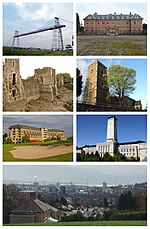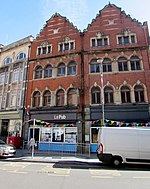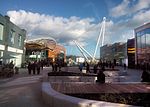Westgate Hotel
Culture in Newport, WalesDefunct hotels in WalesGrade II listed buildings in Newport, WalesHistory of Newport, WalesHotel buildings completed in 1884 ... and 1 more
Structures on the Heritage at Risk register

The Westgate Hotel, Commercial Street, Newport, Wales is a hotel building dating from the 19th century. On 4 November 1839 the hotel saw the major scenes of the Newport Rising, when 3,000 Chartists, some of them armed, led by John Frost marched on Newport to attempt to secure the release of five of their number who were being held under arrest at the hotel. In the fighting between about 60 soldiers of the 45th Regiment of Foot and police on one side, and a larger number of Chartists on the other, 10-22 Chartists were killed and more than 50 wounded. The hotel is a Grade II listed building.
Excerpt from the Wikipedia article Westgate Hotel (License: CC BY-SA 3.0, Authors, Images).Westgate Hotel
Commercial Street, Newport Stow Hill
Geographical coordinates (GPS) Address Website External links Nearby Places Show on map
Geographical coordinates (GPS)
| Latitude | Longitude |
|---|---|
| N 51.5876 ° | E -2.9966 ° |
Address
Westgate Buildings
Commercial Street
NP20 1JL Newport, Stow Hill
Wales, United Kingdom
Open on Google Maps










